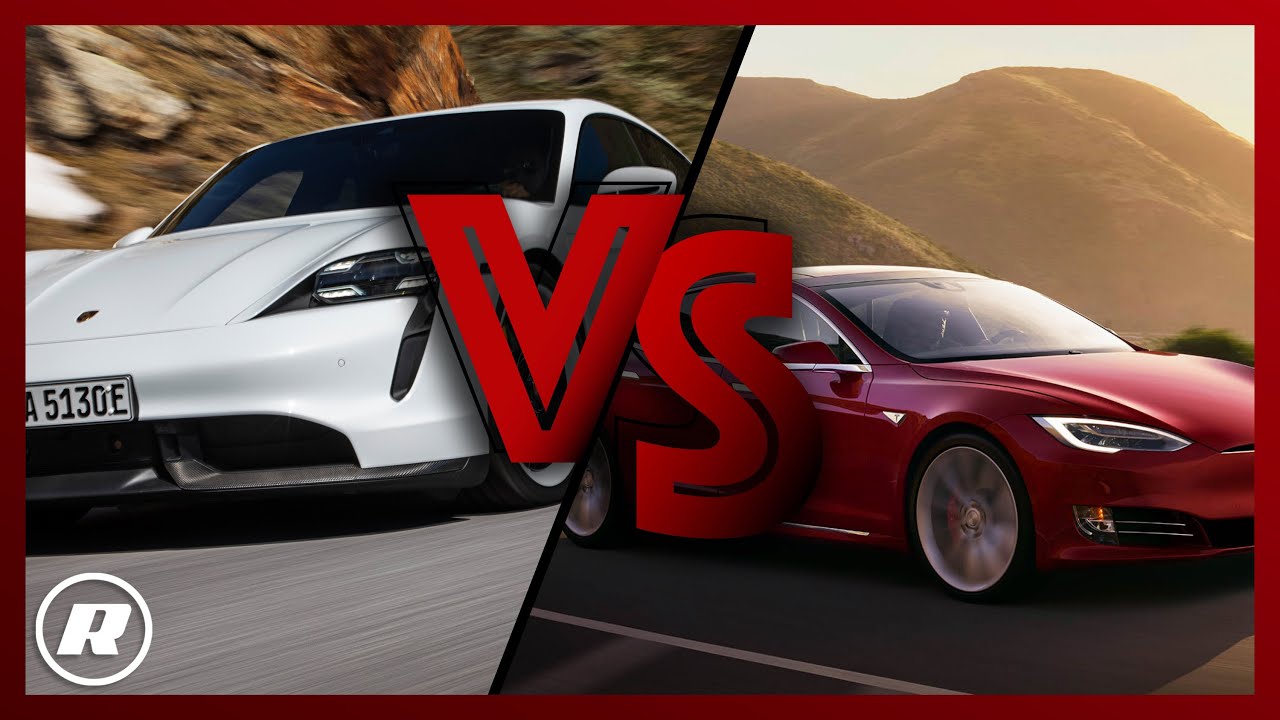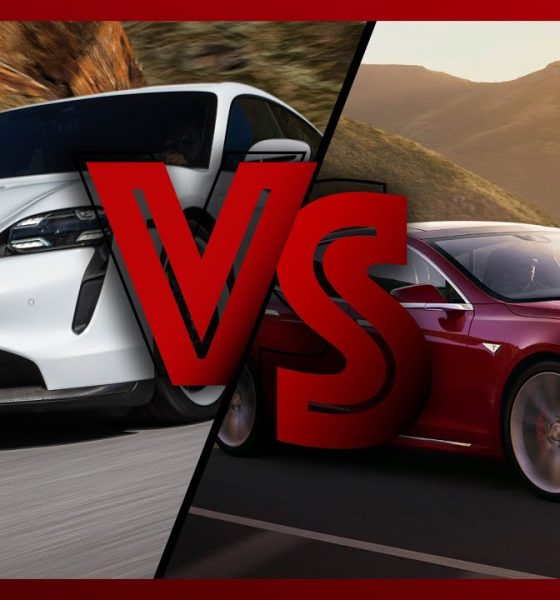

News
Tesla Model S vs Porsche Taycan comparison finally hits the nail on the head
For the longest time, the Tesla Model S and the Porsche Taycan have been compared in a manner that one would not necessarily be considered completely fair. Some would focus on the badge and build quality and automatically give the win to Porsche, while some would focus on tech and driver-assist features and give the win automatically to Tesla. But giving the crown of the best luxury EV on the market today is no joke, and comparing these two vehicles requires a deep dive.
This is something that Roadshow was actually able to accomplish recently. In a video shared on its YouTube channel, the motoring publication compared the Model S and the Taycan on five fronts: Range and Charging, Acceleration, Handling, Design, and Price and Value. Using this metric, the publication was able to reach a result that is actually very fair to both vehicles.
First up is range and charging, and in this sense, there is really no contest. Tesla’s years of work on battery research has paid off in spades, and this is shown by the Model S’ nearly 400-mile range. The Supercharger Network is icing on the cake, providing the Model S with a convenient way to charge its batteries during road trips. The Taycan has a tendency to exceed its EPA range figures, and it’s supported by a vast charging network too. But compared to Tesla’s raw range and Supercharger Network, the gap is simply too big. One win for Tesla.
Acceleration is something that both vehicles excel at. In this sense, Roadshow noted that the top-tier versions of the two premium EVs, the Model S Performance and the Taycan Turbo S, are both insanely quick. The Taycan Turbo S is rated by Porsche with a 0-60 time of 2.6 seconds, but tests from publications have recorded the vehicle hitting 2.4 seconds instead. This was originally faster than the Model S Performance’s 2.5 seconds, but after Tesla’s Cheetah Stance Launch Mode update, the flagship sedan could now hit 60 mph in 2.3 seconds instead. That’s another win for Tesla, but only just.
Things change when handling is discussed. While both are large vehicles, Roadshow noted that the Taycan simply feels much better to throw around corners. This is where Porsche’s pedigree comes to light as a veteran sports car maker, since the Taycan simply feels a lot lighter than its over 5,000-pound weight. The Model S Performance handles great too, but when thrown into the same corners at the same speed as the Taycan, the Tesla’s large size simply becomes more evident. The Taycan wins this round.
Design is also something that was given to the Porsche. After all, the Model S has pretty much retained its design since its first iteration that was rolled out eight years ago. Save for a facelift, the Model S is still the same car that broke barriers back in 2012. Thus, the Taycan simply feels much newer and more fresh in this sense. The fact that the Taycan’s interior is filled to the brim with premium materials worthy of its price also adds to its edge against the Tesla Model S.
But when it comes to the price and value of the two vehicles, it is difficult not to be impressed by the Tesla Model S. Roadshow opted to compare the Taycan 4S and the Model S Long Range, which are the more conservatively priced and specced versions of the two cars. But even then, a fully loaded Model S Long Range is still cheaper than a Taycan 4S that is so basic, it doesn’t even have adaptive cruise control. This, ultimately, proves that eight years on, Tesla’s flagship sedan still has a lot of fight left in it, and it’s not about to give up its crown easily either.

News
Tesla FSD fleet is nearing 7 billion total miles, including 2.5 billion city miles
As can be seen on Tesla’s official FSD webpage, vehicles equipped with the system have now navigated over 6.99 billion miles.

Tesla’s Full Self-Driving (Supervised) fleet is closing in on almost 7 billion total miles driven, as per data posted by the company on its official FSD webpage.
These figures hint at the massive scale of data fueling Tesla’s rapid FSD improvements, which have been quite notable as of late.
FSD mileage milestones
As can be seen on Tesla’s official FSD webpage, vehicles equipped with the system have now navigated over 6.99 billion miles. Tesla owner and avid FSD tester Whole Mars Catalog also shared a screenshot indicating that from the nearly 7 billion miles traveled by the FSD fleet, more than 2.5 billion miles were driven inside cities.
City miles are particularly valuable for complex urban scenarios like unprotected turns, pedestrian interactions, and traffic lights. This is also the difference-maker for FSD, as only complex solutions, such as Waymo’s self-driving taxis, operate similarly on inner-city streets. And even then, incidents such as the San Francisco blackouts have proven challenging for sensor-rich vehicles like Waymos.
Tesla’s data edge
Tesla has a number of advantages in the autonomous vehicle sector, one of which is the size of its fleet and the number of vehicles training FSD on real-world roads. Tesla’s nearly 7 billion FSD miles then allow the company to roll out updates that make its vehicles behave like they are being driven by experienced drivers, even if they are operating on their own.
So notable are Tesla’s improvements to FSD that NVIDIA Director of Robotics Jim Fan, after experiencing FSD v14, noted that the system is the first AI that passes what he described as a “Physical Turing Test.”
“Despite knowing exactly how robot learning works, I still find it magical watching the steering wheel turn by itself. First it feels surreal, next it becomes routine. Then, like the smartphone, taking it away actively hurts. This is how humanity gets rewired and glued to god-like technologies,” Fan wrote in a post on X.
News
Tesla starts showing how FSD will change lives in Europe
Local officials tested the system on narrow country roads and were impressed by FSD’s smooth, human-like driving, with some calling the service a game-changer for everyday life in areas that are far from urban centers.

Tesla has launched Europe’s first public shuttle service using Full Self-Driving (Supervised) in the rural Eifelkreis Bitburg-Prüm region of Germany, demonstrating how the technology can restore independence and mobility for people who struggle with limited transport options.
Local officials tested the system on narrow country roads and were impressed by FSD’s smooth, human-like driving, with some calling the service a game-changer for everyday life in areas that are far from urban centers.
Officials see real impact on rural residents
Arzfeld Mayor Johannes Kuhl and District Administrator Andreas Kruppert personally tested the Tesla shuttle service. This allowed them to see just how well FSD navigated winding lanes and rural roads confidently. Kruppert said, “Autonomous driving sounds like science fiction to many, but we simply see here that it works totally well in rural regions too.” Kuhl, for his part, also noted that FSD “feels like a very experienced driver.”
The pilot complements the area’s “Citizen Bus” program, which provides on-demand rides for elderly residents who can no longer drive themselves. Tesla Europe shared a video of a demonstration of the service, highlighting how FSD gives people their freedom back, even in places where public transport is not as prevalent.
What the Ministry for Economic Affairs and Transport says
Rhineland-Palatinate’s Minister Daniela Schmitt supported the project, praising the collaboration that made this “first of its kind in Europe” possible. As per the ministry, the rural rollout for the service shows FSD’s potential beyond major cities, and it delivers tangible benefits like grocery runs, doctor visits, and social connections for isolated residents.
“Reliable and flexible mobility is especially vital in rural areas. With the launch of a shuttle service using self-driving vehicles (FSD supervised) by Tesla in the Eifelkreis Bitburg-Prüm, an innovative pilot project is now getting underway that complements local community bus services. It is the first project of its kind in Europe.
“The result is a real gain for rural mobility: greater accessibility, more flexibility and tangible benefits for everyday life. A strong signal for innovation, cooperation and future-oriented mobility beyond urban centers,” the ministry wrote in a LinkedIn post.
News
Tesla China quietly posts Robotaxi-related job listing
Tesla China is currently seeking a Low Voltage Electrical Engineer to work on circuit board design for the company’s autonomous vehicles.

Tesla has posted a new job listing in Shanghai explicitly tied to its Robotaxi program, fueling speculation that the company is preparing to launch its dedicated autonomous ride-hailing service in China.
As noted in the listing, Tesla China is currently seeking a Low Voltage Electrical Engineer to work on circuit board design for the company’s autonomous vehicles.
Robotaxi-specific role
The listing, which was shared on social media platform X by industry watcher @tslaming, suggested that Tesla China is looking to fill the role urgently. The job listing itself specifically mentions that the person hired for the role will be working on the Low Voltage Hardware team, which would design the circuit boards that would serve as the nervous system of the Robotaxi.
Key tasks for the role, as indicated in the job listing, include collaboration with PCB layout, firmware, mechanical, program management, and validation teams, among other responsibilities. The role is based in Shanghai.
China Robotaxi launch
China represents a massive potential market for robotaxis, with its dense urban centers and supportive policies in select cities. Tesla has limited permission to roll out FSD in the country, though despite this, its vehicles have been hailed as among the best in the market when it comes to autonomous features. So far, at least, it appears that China supports Tesla’s FSD and Robotaxi rollout.
This was hinted at in November, when Tesla brought the Cybercab to the 8th China International Import Expo (CIIE) in Shanghai, marking the first time that the autonomous two-seater was brought to the Asia-Pacific region. The vehicle, despite not having a release date in China, received a significant amount of interest among the event’s attendees.








